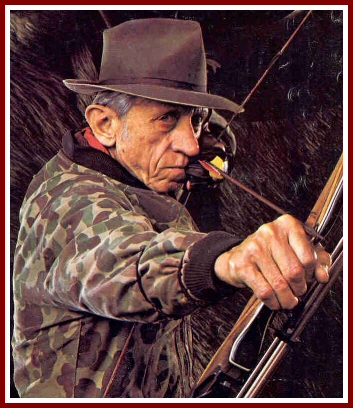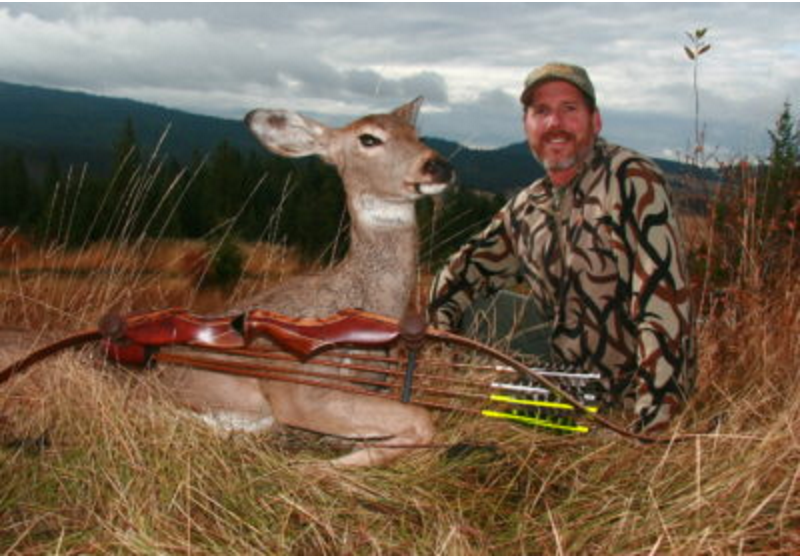WATCH: How to Extend Your Effective Bowhunting Distance
With today’s technological advances, is a recurve or longbow that incorporates cutting-edge materials and manufacturing methods still a traditional bow?
Considering the remarkable advancements with today’s compound bows, it was inevitable some of that technology would make its way into traditional archery. That makes for an interesting dichotomy. Is a recurve or longbow that incorporates cutting-edge materials and manufacturing methods still a traditional bow?
I suspect that traditional archers asked the same question when the legendary Fred Bear patented the use of that newfangled fiberglass as bow backing in 1946. Surely, some of those who doted on bows made of yew, bamboo, osage or hickory must have believed that Bear’s bows were unholy.

Technology’s Impact
On Traditional Archery
Since the formative years of the fiberglass-backed recurve, technical advancements with traditional bows have come slowly. Much of the initial testing with limb design is still valid. Many of the early recurves are excellent shooters by today’s standards.
Popular demand for the Bear Kodiak, created in 1959, persuaded Bear Archery to reintroduce that bow, with some improvements, in 2013. Likewise, Martin Archery brought back its Super Diablo recurve, which was popular in the 1960s.
I shot the Bear Super Kodiak, which debuted in 1967, at the 2013 Archery Trade Association show in Louisville, Ky. I found it to be smooth, quiet and comfortable. The fact that Fred Bear used the Super Kodiak to kill African lion, cape buffalo, Alaskan polar bear and a British Columbia grizzly attests to it lethality.
Although the initial design of the Super Kodiak is the same, there have been refinements through the years. This is true of most modern traditional bows that have wood limbs backed with fiberglass.
“About 25 years ago, we switched from maple limbs to what we call Actionwood,” said Neil Byce, a second-generation master bowyer at Bear Archery.
Actionwood consists of 1/8-inch-thick maple laminations that are glued together and cut across the grain. This results in several laminations across the width of the limb. Actionwood eliminates potential warping and improves performance. Many other types of wood are used in traditional bow limbs, including bamboo and ironwood.
Noteworthy innovations that have been around a while include take-down bows and reinforced tips that can withstand thinner Fast Flight strings. With longbows, the reflex-deflex limb design provided a substantial leap in performance.
Carbon
The most recent traditional bow breakthroughs have come via Olympic archery, where the recurve rules. The urge to win has driven competitive archers to make recurve bows that zip light arrows on a flat trajectory to a target 70 meters away. Repeatable precision is vital, given that the gold ring is only 4.8 inches in diameter.

Bowhunter Rob Kaufhold, president of Lancaster Archery Supply, has been shooting in Olympic-style archery competitions for more than 45 years. He has incorporated the latest Olympic bow enhancements into his own TradTech Archery brand hunting bows.
The biggest advancement passed down to traditional hunting bows from the Olympians is the use of carbon in the limbs. Carbon is lighter and quicker than wood.
“Limbs with carbon shoot 8 to 10 fps faster than fiberglassbacked wood limbs of the same design,” Kaufhold said. ”The flatter arrow trajectory gives you more room for error.”
TradTech’s flagship hunting recurve is the Titan III. This take-down bow features a 19-inch Metal Riser and Black Max Carbon Limbs comprised of Zentron S-Bias Carbon and hardrock maple under black fiberglass ($648). The limbs are easily adjustable for tiller (for shooting split-finger or three- under) and for a 10 percent increase in draw weight. You can also adjust lateral limb alignment to accommodate various shooting styles.
The metal and wood risers in TradTech takedown recurves adhere to the International Limb Fitting standard, which is common with Olympic bows. ILF limbs from any manufacturer will fit any ILF riser. You are likely to see more ILF limbs and risers in future hunting bows.
Hoyt has stepped into the ILF realm with its Buffalo recurve, which is outfitted with a metal riser and carbon, wood and fiberglass limbs ($729.99). The Buffalo’s Paralever Limb System lets you adjust the limbs for the ideal tiller.
Something not common with high-tech traditional hunting bows, but sure to come, are limbs that include syntactic foam. Unlike wood, syntactic foam remains stable during extreme ranges of temperature and humidity, maintaining the same point of impact. TradTech’s Extreme BF Carbon Limbs ($629) are the only ones that combine syntactic foam with wood-core laminations.
Metal and Modern Materials
High-end metal and wooden risers are typically cut with CNC machines, including those offered by Black Widow. This ensures exact duplication and precision limb fittings. Wooden risers garner the most sales, but metal risers appeal to those who are more interested in performance than traditional styling. Stiffer metal risers increase performance, and some of them let you adjust the limbs for poundage and tiller.
“Hunters who buy metal risers want the most efficient tool they can get,” Kaufhold said.
He believes a high-tech, flat-shooting recurve is the best possible bow — even better than a compound — for hunting whitetails in woodland settings, where most shots are 20 yards or closer.
“When you have to thread an arrow through limbs and branches or take a shot a rutting buck that won’t stop, a fast recurve is the best tool for the job,” Kaufhold said.
Some hunters find a bridged metal riser to be especially eye appealing, such as Martin’s new 62-inch Diablo take-down. Its machined aluminum riser has rubber vibration dampers called Vibration Vortex VEMs.
Win & Win Archery, a big player with Olympic bows and a leader in recurve limb design, has a new ultra-modern traditional hunting bow, the Carbon Tech RCX 17 ($784). It’s available in 58-, 60- and 62-inch lengths. I was stunned by this recurve’s lightness when I picked it up at the ATA show. Thanks to a 17-inch carbon riser and carbon/fiberglass Win & Win limbs, the bow weighs just 2.5 pounds.
In addition to its lightness, the carbon riser excels at dampening vibrations and is warm to the touch in cold weather. Carbon limbs and metal risers are not limited to recurve bows. There are also many reflex-deflex longbows bolstered by this technology. Longbows are generally quieter than recurves because the string does not slap the limb. This is why some traditional bowhunters prefer longbows.

Arrows
The most diehard traditionalists still shoot wooden arrows, with cedar being the most popular. Although aluminum arrows ruled the roost with traditional bowhunters for decades, carbon arrows have surpassed aluminum by a wide margin.
Carbon arrows are much tougher than those of wood or aluminum. If a carbon arrow isn’t broken, you know it is straight. Carbon arrows also recover faster after leaving the bow and have better penetration because of their smaller diameter and superior stiffness on impact. And, they are the most accurate and forgiving arrows a traditional bowhunter can shoot.
An arrow from even the fastest high-tech traditional bow barely exceeds 200 fps. Because this is dramatically slower than what a compound bow delivers, traditional bowhunters generally opt for heavier carbon arrows to achieve deep penetration.
“For deer, I recommend arrows that weigh 8 to 10 grains per pound of your bow’s draw weight, including the nock, shaft, fletching, insert and broadhead,” Kaufhold said. “That works out to a 400- to 500-grain arrow for a 50-pound bow.”
Companies that make carbon arrow shafts haven’t overlooked traditional bowhunters. Some carbon shafts have a mock wood-grain finish, but their attraction is far more than skin deep. Easton’s new Axis traditional arrows weigh 7.9 grains per inch and have a 50- to 75-grain brass insert. Add a broadhead and feathers, and the weight is more than 400 grains.
Beman’s Center Shot shafts weigh 9.6 gpi and carry a 100-grain insert. A finished arrow with this shaft weighs about 500 grains and will hammer deer-sized game. The Rhino Shaft from Carbon Tech is available in 9.5, 10.0 and 11.5 gpi. The heavier sizes will put the big hurt on elk, moose and grizzlies.
Inserts and Broadheads
with some carbon arrows give the shaft a weight-forward balance. This improves arrow flight and significantly increases penetration. You can increase the tip weight of arrows that don’t have inserts with steel screw-in broadhead adapters. They come as heavy as 125 grains and give your arrows a knockout punch.
The one place where traditional bowhunters have stayed true to form is with broadheads. Two- and three-blade broadheads that have been around for decades still dispatch deer efficiently. Popular brands include Grizzly, Magnus, Woodsman and Zwickey. There are many other capable brands to choose from. Some of these broadheads have large surface areas. Do they cause problems with wind planing?
“No,” Kaufhold said. “Typically, wind planing only begins at speeds faster than 240 fps. Poor broadhead flight is normally because of arrows that are too stiff or too weak in spine. Other causes are an incorrect nocking point, fletching clearance issues or broadhead misalignment on the shaft.”


